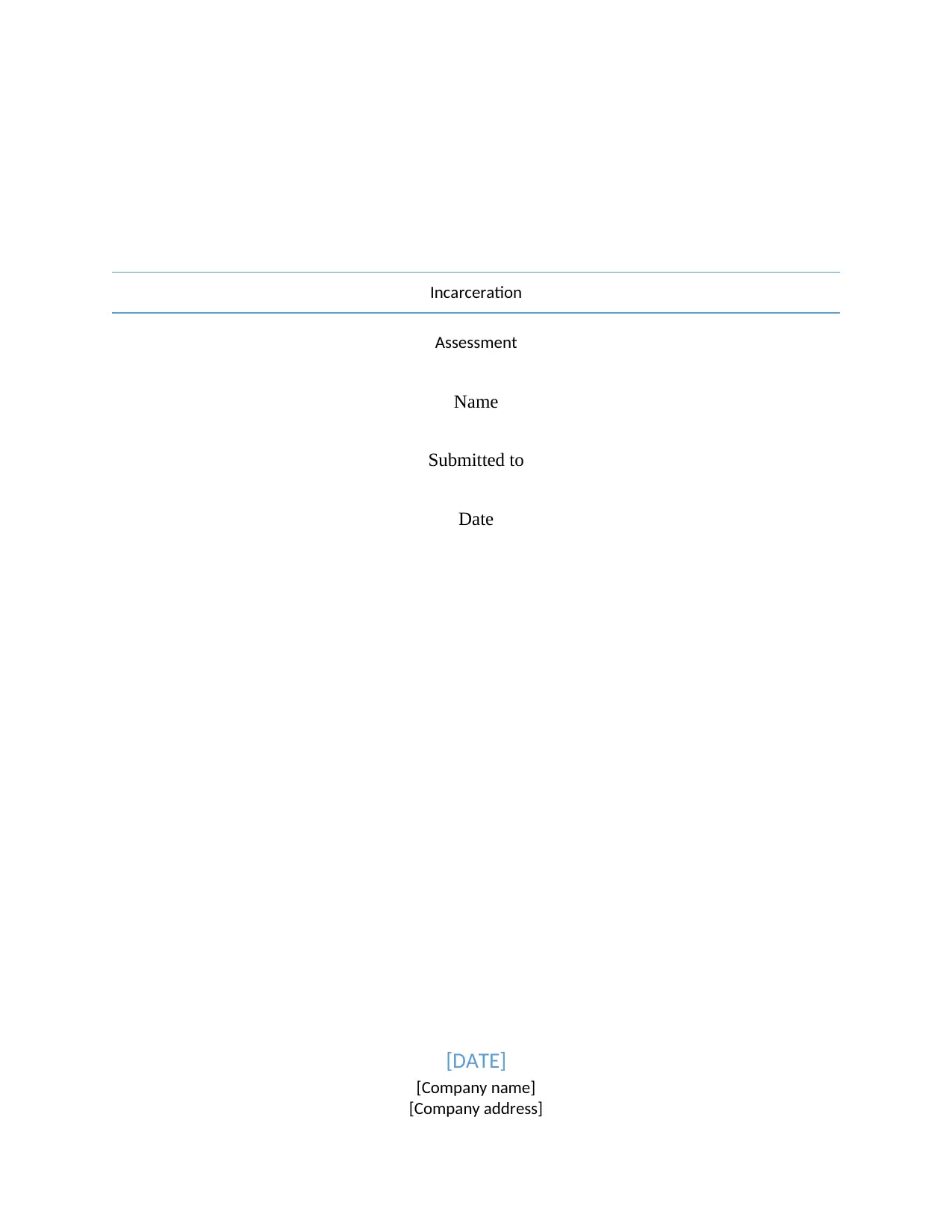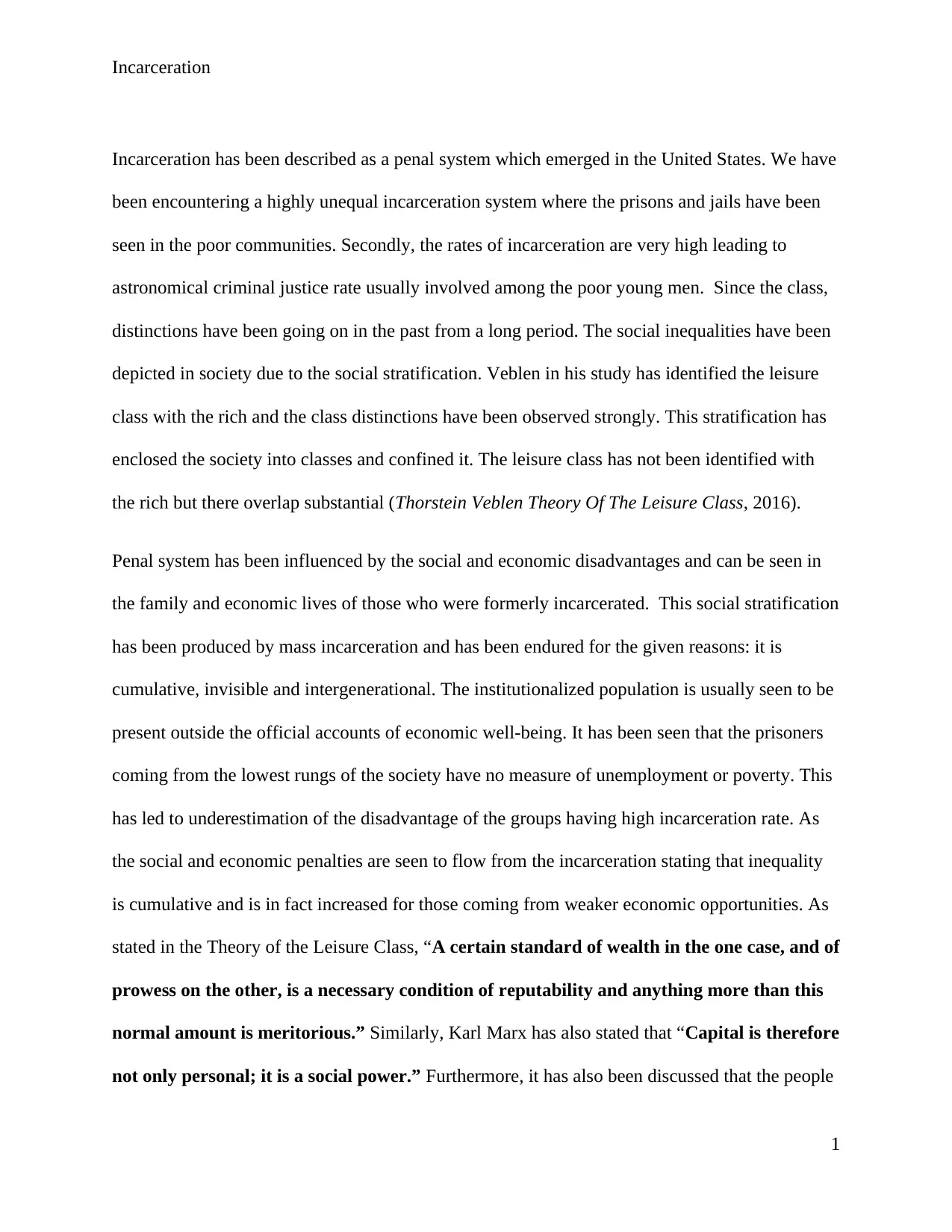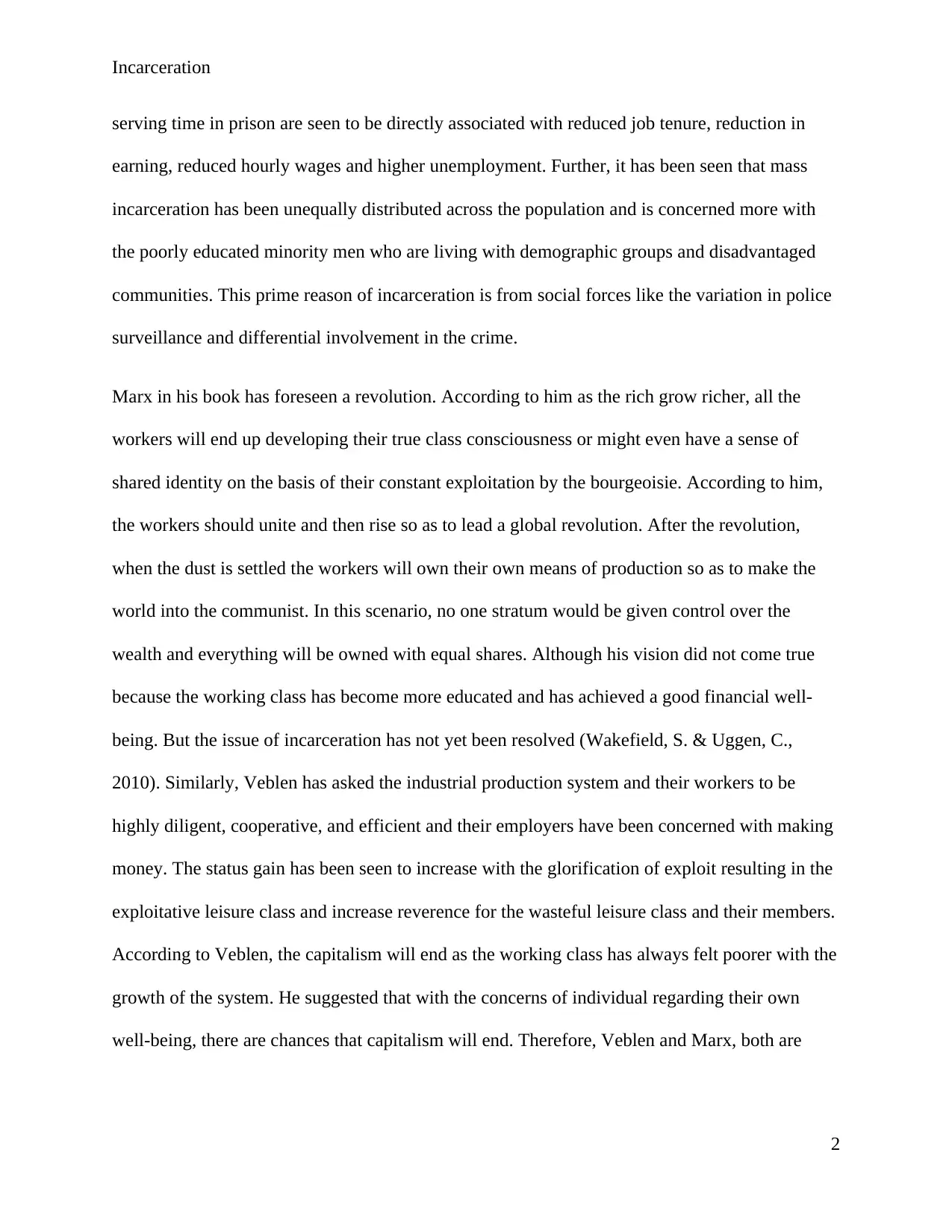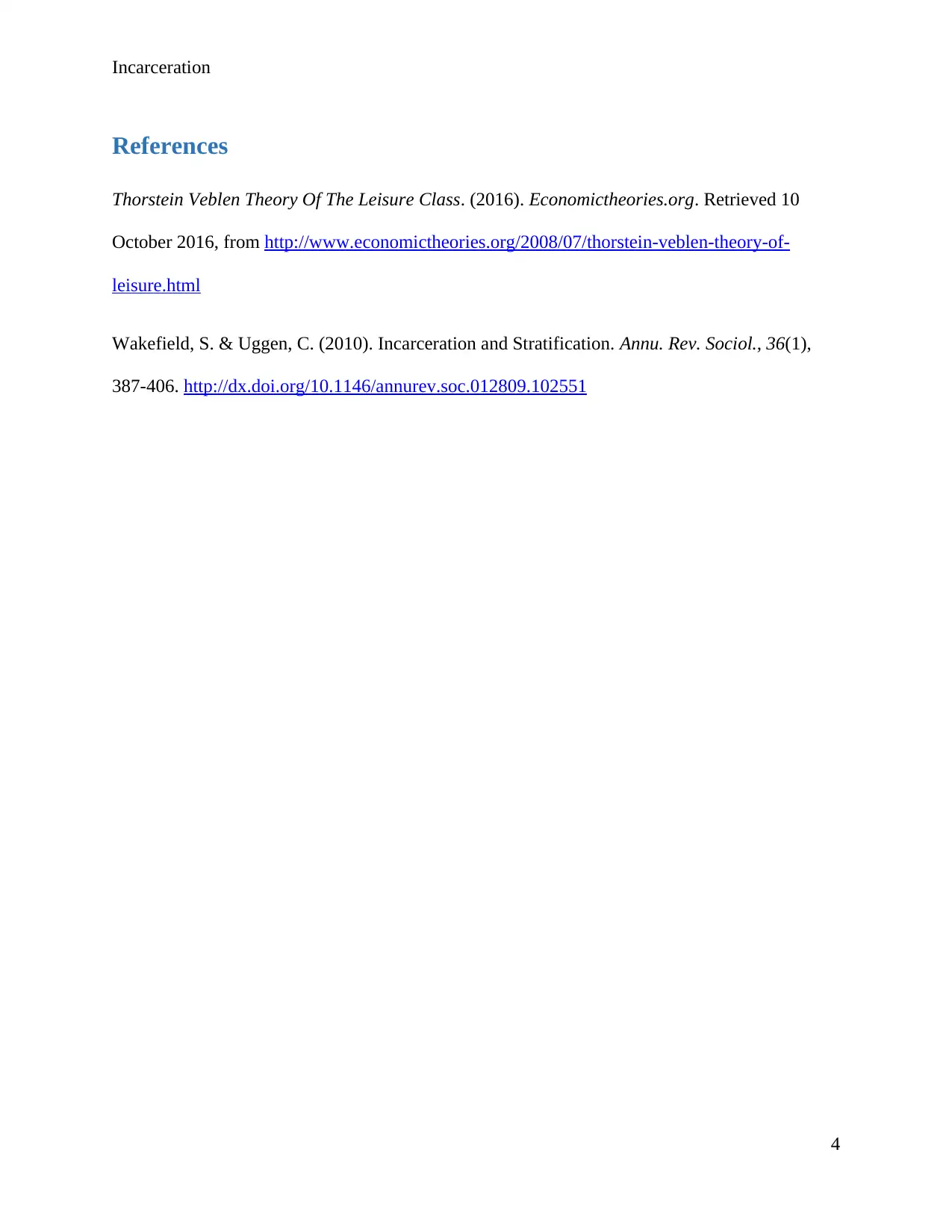Incarceration and its Role in Cumulative Social Stratification
VerifiedAdded on 2019/09/22
|5
|843
|429
Essay
AI Summary
This essay examines incarceration as a penal system in the United States, highlighting its unequal distribution among poor communities and its contribution to social stratification. It discusses how incarceration affects the economic and family lives of formerly incarcerated individuals, perpetuating cumulative, invisible, and intergenerational inequalities. The essay references Veblen's theory of the leisure class and Marx's analysis of class consciousness, drawing parallels between their critiques of capitalism and the issue of incarceration. Both theorists suggest that capitalism's inherent flaws lead to social disparities, although their proposed solutions differ. The essay concludes by emphasizing the need to address the social forces driving incarceration, particularly among disadvantaged communities, and its long-term impact on economic opportunities and social mobility.

Incarceration
Assessment
Name
Submitted to
Date
[DATE]
[Company name]
[Company address]
Assessment
Name
Submitted to
Date
[DATE]
[Company name]
[Company address]
Paraphrase This Document
Need a fresh take? Get an instant paraphrase of this document with our AI Paraphraser

Incarceration
Incarceration has been described as a penal system which emerged in the United States. We have
been encountering a highly unequal incarceration system where the prisons and jails have been
seen in the poor communities. Secondly, the rates of incarceration are very high leading to
astronomical criminal justice rate usually involved among the poor young men. Since the class,
distinctions have been going on in the past from a long period. The social inequalities have been
depicted in society due to the social stratification. Veblen in his study has identified the leisure
class with the rich and the class distinctions have been observed strongly. This stratification has
enclosed the society into classes and confined it. The leisure class has not been identified with
the rich but there overlap substantial (Thorstein Veblen Theory Of The Leisure Class, 2016).
Penal system has been influenced by the social and economic disadvantages and can be seen in
the family and economic lives of those who were formerly incarcerated. This social stratification
has been produced by mass incarceration and has been endured for the given reasons: it is
cumulative, invisible and intergenerational. The institutionalized population is usually seen to be
present outside the official accounts of economic well-being. It has been seen that the prisoners
coming from the lowest rungs of the society have no measure of unemployment or poverty. This
has led to underestimation of the disadvantage of the groups having high incarceration rate. As
the social and economic penalties are seen to flow from the incarceration stating that inequality
is cumulative and is in fact increased for those coming from weaker economic opportunities. As
stated in the Theory of the Leisure Class, “A certain standard of wealth in the one case, and of
prowess on the other, is a necessary condition of reputability and anything more than this
normal amount is meritorious.” Similarly, Karl Marx has also stated that “Capital is therefore
not only personal; it is a social power.” Furthermore, it has also been discussed that the people
1
Incarceration has been described as a penal system which emerged in the United States. We have
been encountering a highly unequal incarceration system where the prisons and jails have been
seen in the poor communities. Secondly, the rates of incarceration are very high leading to
astronomical criminal justice rate usually involved among the poor young men. Since the class,
distinctions have been going on in the past from a long period. The social inequalities have been
depicted in society due to the social stratification. Veblen in his study has identified the leisure
class with the rich and the class distinctions have been observed strongly. This stratification has
enclosed the society into classes and confined it. The leisure class has not been identified with
the rich but there overlap substantial (Thorstein Veblen Theory Of The Leisure Class, 2016).
Penal system has been influenced by the social and economic disadvantages and can be seen in
the family and economic lives of those who were formerly incarcerated. This social stratification
has been produced by mass incarceration and has been endured for the given reasons: it is
cumulative, invisible and intergenerational. The institutionalized population is usually seen to be
present outside the official accounts of economic well-being. It has been seen that the prisoners
coming from the lowest rungs of the society have no measure of unemployment or poverty. This
has led to underestimation of the disadvantage of the groups having high incarceration rate. As
the social and economic penalties are seen to flow from the incarceration stating that inequality
is cumulative and is in fact increased for those coming from weaker economic opportunities. As
stated in the Theory of the Leisure Class, “A certain standard of wealth in the one case, and of
prowess on the other, is a necessary condition of reputability and anything more than this
normal amount is meritorious.” Similarly, Karl Marx has also stated that “Capital is therefore
not only personal; it is a social power.” Furthermore, it has also been discussed that the people
1

Incarceration
serving time in prison are seen to be directly associated with reduced job tenure, reduction in
earning, reduced hourly wages and higher unemployment. Further, it has been seen that mass
incarceration has been unequally distributed across the population and is concerned more with
the poorly educated minority men who are living with demographic groups and disadvantaged
communities. This prime reason of incarceration is from social forces like the variation in police
surveillance and differential involvement in the crime.
Marx in his book has foreseen a revolution. According to him as the rich grow richer, all the
workers will end up developing their true class consciousness or might even have a sense of
shared identity on the basis of their constant exploitation by the bourgeoisie. According to him,
the workers should unite and then rise so as to lead a global revolution. After the revolution,
when the dust is settled the workers will own their own means of production so as to make the
world into the communist. In this scenario, no one stratum would be given control over the
wealth and everything will be owned with equal shares. Although his vision did not come true
because the working class has become more educated and has achieved a good financial well-
being. But the issue of incarceration has not yet been resolved (Wakefield, S. & Uggen, C.,
2010). Similarly, Veblen has asked the industrial production system and their workers to be
highly diligent, cooperative, and efficient and their employers have been concerned with making
money. The status gain has been seen to increase with the glorification of exploit resulting in the
exploitative leisure class and increase reverence for the wasteful leisure class and their members.
According to Veblen, the capitalism will end as the working class has always felt poorer with the
growth of the system. He suggested that with the concerns of individual regarding their own
well-being, there are chances that capitalism will end. Therefore, Veblen and Marx, both are
2
serving time in prison are seen to be directly associated with reduced job tenure, reduction in
earning, reduced hourly wages and higher unemployment. Further, it has been seen that mass
incarceration has been unequally distributed across the population and is concerned more with
the poorly educated minority men who are living with demographic groups and disadvantaged
communities. This prime reason of incarceration is from social forces like the variation in police
surveillance and differential involvement in the crime.
Marx in his book has foreseen a revolution. According to him as the rich grow richer, all the
workers will end up developing their true class consciousness or might even have a sense of
shared identity on the basis of their constant exploitation by the bourgeoisie. According to him,
the workers should unite and then rise so as to lead a global revolution. After the revolution,
when the dust is settled the workers will own their own means of production so as to make the
world into the communist. In this scenario, no one stratum would be given control over the
wealth and everything will be owned with equal shares. Although his vision did not come true
because the working class has become more educated and has achieved a good financial well-
being. But the issue of incarceration has not yet been resolved (Wakefield, S. & Uggen, C.,
2010). Similarly, Veblen has asked the industrial production system and their workers to be
highly diligent, cooperative, and efficient and their employers have been concerned with making
money. The status gain has been seen to increase with the glorification of exploit resulting in the
exploitative leisure class and increase reverence for the wasteful leisure class and their members.
According to Veblen, the capitalism will end as the working class has always felt poorer with the
growth of the system. He suggested that with the concerns of individual regarding their own
well-being, there are chances that capitalism will end. Therefore, Veblen and Marx, both are
2
⊘ This is a preview!⊘
Do you want full access?
Subscribe today to unlock all pages.

Trusted by 1+ million students worldwide

Incarceration
stating that capitalism must be abolished but have different concepts and ideas on both. Veblen,
therefore, states that capitalism will cease because of its own success.
3
stating that capitalism must be abolished but have different concepts and ideas on both. Veblen,
therefore, states that capitalism will cease because of its own success.
3
Paraphrase This Document
Need a fresh take? Get an instant paraphrase of this document with our AI Paraphraser

Incarceration
References
Thorstein Veblen Theory Of The Leisure Class. (2016). Economictheories.org. Retrieved 10
October 2016, from http://www.economictheories.org/2008/07/thorstein-veblen-theory-of-
leisure.html
Wakefield, S. & Uggen, C. (2010). Incarceration and Stratification. Annu. Rev. Sociol., 36(1),
387-406. http://dx.doi.org/10.1146/annurev.soc.012809.102551
4
References
Thorstein Veblen Theory Of The Leisure Class. (2016). Economictheories.org. Retrieved 10
October 2016, from http://www.economictheories.org/2008/07/thorstein-veblen-theory-of-
leisure.html
Wakefield, S. & Uggen, C. (2010). Incarceration and Stratification. Annu. Rev. Sociol., 36(1),
387-406. http://dx.doi.org/10.1146/annurev.soc.012809.102551
4
1 out of 5
Related Documents
Your All-in-One AI-Powered Toolkit for Academic Success.
+13062052269
info@desklib.com
Available 24*7 on WhatsApp / Email
![[object Object]](/_next/static/media/star-bottom.7253800d.svg)
Unlock your academic potential
Copyright © 2020–2025 A2Z Services. All Rights Reserved. Developed and managed by ZUCOL.




